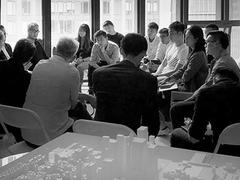
SCDA × NUS Design Studio 2019
NEW YORK
September, 2019
NYC 2040—Beyond Pencil Towers
Led by Associate Professor Dr. Joseph Lim, (M.Arch Program Director, NUS Architecture), Soo K. Chan of SCDA and Dr. Hossein Rezai Jorabi, this was a cross-continental studio at the National University of Singapore’s Department of Architecture, involving site visits and studio reviews that took place in New York City.
This academic studio examines two massive city blocks in the neighborhood of West Chelsea, Manhattan housing a centralized mail depot for the US Postal Service. The studio project hypothesizes a cutting-edge design hub within the Manhattan grid, programmatically engaging in inventive / creative production for the new economy; with events and maker programs for public participation—all while physically occupying prime real estate in one of the densest cities on our planet—in the year 2040.
As the phased-development of New York’s Hudson Yards neighborhood continues to see ever-new construction in recent years, the studio centers on the adjacent USPS Morgan Postal Facility as test site—to speculate on what the urban city block of the future might look like, and to ask questions of architecture surrounding various key themes:
CREATIVITY
- What will the future cityscape of creative production and global collaboration look like?
- How can a new city be planned, with storefronts of knowledge, and streets of learning?
- How can micro city-districts be planned to be engines of creative growth and production?
SCALE
- Is there an alternative architectural scale of existence for the New York City of the future?
- Are there ideal block and/or street configurations which can be ‘transposed’ over the existing grid?
- How do we investigate new structural configurations to maximize street frontages beyond the ground plane?
MOBILITY
- What ultra-modern forms of transportation can supersede incumbent forms and generate a new city of the future?
- What solutions might there be to mitigate traffic-generated problems, and the conundrum of public infrastructure cannibalizing urban real estate that would otherwise be productively developed?
KEY CONSIDERATIONS IN THE YEAR 2040
- Population of 9 million, with 35% non-US citizens
- Increased proportion of shared (public) facilities for creative production, public places amenities, and commercial enterprise in land usage that utilizes airspace
- The creation of hybrid programs
- The assumption of substantially increased population and thus density in the city
- The assumption of ‘infrastructure overload’
- The predominance of repurposing buildings and infrastructure over time, and the death of the skyscraper as a viable model for urban redevelopment
Additional Material: